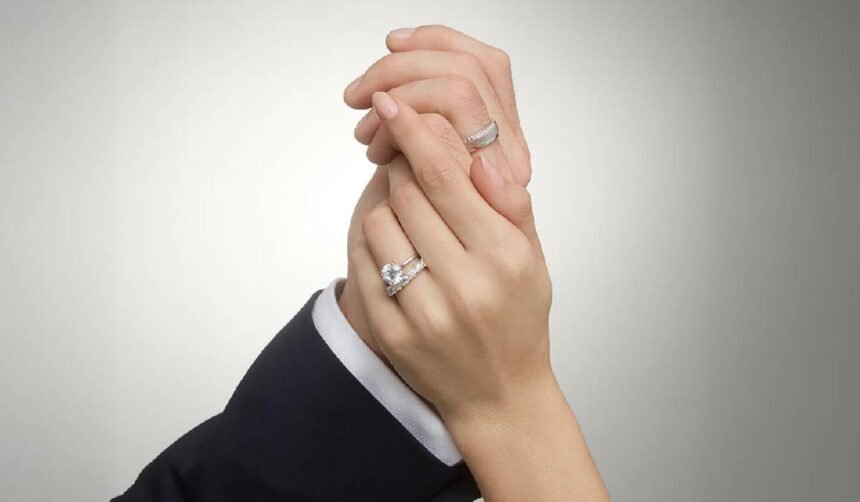Men spend between $5,200 and $7,168 on average for engagement rings in the United States. Regional differences push these numbers higher in states like Washington, where buyers spend $10,109, and California at $9,482. Despite these investments, many purchasers make preventable errors that result in additional costs, partner dissatisfaction, or long-term maintenance problems.
The Ring Size Guessing Game
Approximately 30% of engagement rings need resizing after purchase. Men often borrow a ring from their partner’s jewelry box without confirming it fits the correct finger. Ring fingers vary in size from other fingers, and rings worn occasionally might not match daily wear requirements. Temperature changes and water retention affect finger size throughout the day, making single-point measurements unreliable.
Resizing costs range from $50 to $200 per adjustment, but some ring designs cannot be resized at all. Eternity bands with stones around the entire circumference and tension settings lose structural integrity when altered. Platinum rings require specialized equipment that many local jewelers lack, leading to shipping costs and extended wait times.
Ignoring Her Actual Style
Data from Rêve Diamonds shows 41% of men never consult their partner about ring preferences. These buyers default to what jewelry stores display prominently or what they remember from movies. The result often disappoints recipients who had specific designs in mind for years.
Social media accounts and Pinterest boards contain direct evidence of style preferences. Friends and family members usually know these preferences but men rarely ask them. Some women prefer colored gemstones like sapphires or emeralds over diamonds. Others want vintage Art Deco settings or minimalist bands that suit their professional environments.
Assuming Shape Preferences Without Research
Men frequently purchase rings based on what they think looks impressive rather than what their partner actually wants. Round diamonds dominate sales floors, but many women prefer emerald cut diamonds, oval stones, or pear shapes that better suit their hand proportions and personal taste. Jewelers report that shape preference correlates strongly with personality and lifestyle factors that men rarely consider during selection.
The assumption that bigger means better leads to poor trade-offs between size and quality. A buyer might choose a larger round diamond with visible inclusions over a smaller, flawless stone in their partner’s preferred shape. This mistake becomes apparent when women compare rings with friends or see alternatives that better match their aesthetic preferences.
Misreading Diamond Grades
Only 40% of male buyers understand diamond grading systems. The Four Cs create confusion when buyers encounter technical certificates without context. A buyer might pay premium prices for colorless grades when slight color variations remain invisible to untrained eyes. Clarity grades above VS2 rarely show visible differences, yet sellers push buyers toward VVS ratings at substantially higher prices.
Cut quality affects sparkle more than other factors, but buyers focus on carat weight. A poorly cut two-carat diamond looks duller than a well-cut one-carat stone. Certification matters too. GIA and AGS provide consistent grading while other laboratories use looser standards that inflate quality claims.
Overlooking Practical Wear Requirements
Delicate pavé settings look elegant in display cases but snag on clothing and require frequent repairs. Women in healthcare, fitness instruction, or manual trades need sturdy settings that withstand constant hand movement and cleaning. Low-profile bezels and channel settings protect stones better than high-mounted solitaires.
Metal selection affects durability differently than most buyers expect. White gold requires rhodium replating every two years at $60 to $120 per treatment. Platinum scratches easily but retains metal volume, while gold wears away over time. These maintenance requirements add hundreds of dollars annually to ownership costs.
Timeline Miscalculations
The Gemological Institute of America recommends starting ring shopping three months before proposal plans. Custom designs require six to eight weeks for completion. Holiday seasons extend these timelines further as demand increases. Men who start shopping two weeks before their planned proposal date limit themselves to immediate inventory, paying premium prices for rush orders.
Financing terms deserve careful examination. Zero-interest promotions often convert to 24% annual rates if balances remain after promotional periods. Payment plans that extend beyond two years typically cost more in interest than saving money beforehand.
Missing Customization Details
Customization extends beyond selecting stones and settings. Ring width affects comfort and appearance on different hand sizes. Band thickness determines long-term durability. Interior comfort fits reduce friction but cost extra. Engraving placement limits future resizing options.
Yellow gold represents 41% of current sales according to Rêve Diamonds, reversing white metal dominance from previous decades. Rose gold oxidizes differently than yellow gold, requiring specific maintenance. Mixed metal designs complicate repairs and refinishing. Buyers who select trendy combinations without considering these factors face unexpected costs later.
Post-Purchase Planning Gaps
Annual maintenance costs between $100 and $300 include professional cleaning, prong tightening, and inspection services. Insurance premiums average 1-2% of ring value yearly. Warranties cover different problems, with some excluding normal wear while others require annual inspections to remain valid.
Storage matters for ring preservation. Separate compartments prevent diamonds from scratching other jewelry. Humidity control stops certain metals from tarnishing. Travel cases protect rings during transportation. Men rarely purchase these items alongside rings, leading to preventable damage during the engagement period.







